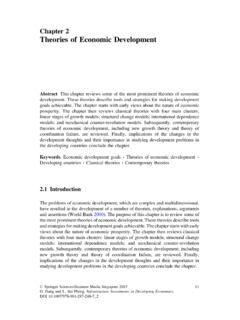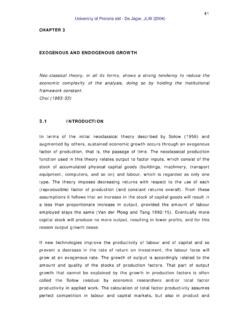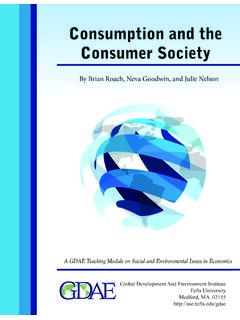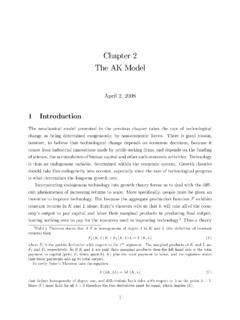Transcription of Models of Economic Growth - EOLSS
1 UNESCO EOLSSSAMPLE CHAPTERSMATHEMATICAL Models IN ECONOMICS - Vol. II - Models of Economic Growth - Alfred Greiner Encyclopedia of Life Support Systems ( EOLSS ) Models OF Economic Growth Alfred Greiner Department of Business Administration and Economics, Bielefeld University, Germany Keywords: Stylized facts, marginal product of capital, endogenous Growth , investment, externalities, knowledge, human capital, infrastructure capital, fiscal policy, dynamics, and indeterminacy. Contents 1.
2 Introduction 2. Stylized facts 3. Exogenous Growth Models The Harrod-Domar Growth model The Neoclassical model 4. Endogenous Growth Models Externalities of Investment Knowledge Accumulation Human Capital Formation Public Infrastructure 5. Conclusion Appendix Acknowledgements Glossary Bibliography Biographical Sketch Summary This chapter presents a survey of Models of Economic Growth starting with the Harrod-Domar Growth model , which is based on Keynesian ideas of incomplete markets, and continues with the neoclassical model of exogenous Growth .
3 In the latter, the supply side plays the decisive role and the article characterizes the properties of this basic Growth model . A shortcoming of this model is that it cannot endogenously explain sustained per-capita Growth , which is an empirically observed fact in market economies, but has to resort to exogenously given technical change. The reason for this problem lies in the fact that the production function is characterized by a declining marginal product of physical capital which reduces the incentive to invest as capital rises.
4 As a consequence, the economy converges to a steady state in the long-run where investment is just sufficiently high to keep the per-capita capital stock constant. The endogenous Growth theory could overcome this shortcoming by postulating that there exist endogenous factors that have positive effects on the marginal product of capital. This contribution depicts fundamental endogenous Growth Models starting with the model where investment is associated with positive externalities on the macroeconomic level.
5 These externalities raise the marginal product of capital and prevent that the incentive to invest vanishes as capital grows, leading to sustained Growth in the long-run. Another class of endogenous Growth Models assumes that research and development is undertaken by profit maximizing firms thus raising the stock of knowledge that UNESCO EOLSSSAMPLE CHAPTERSMATHEMATICAL Models IN ECONOMICS - Vol. II - Models of Economic Growth - Alfred Greiner Encyclopedia of Life Support Systems ( EOLSS ) generates sustained per-capita Growth .
6 The last two class of Models presented are the one with human capital formation as the source of ongoing Growth and the one where the government continually invests in public infrastructure which has a stimulating effect on the private investment share. The article also discusses the dynamic behavior of the Models presented and points out empirical evidence for each class of Models . 1. Introduction Over the 18th, 19th, and 20th centuries aggregate production has been more or less steadily increasing in most countries of the world.
7 This holds both as concerns overall output as well as concerns production per capita. So, the per-capita gross domestic product (GDP) in the world quadrupled from 1900 to the early 1990 s, corresponding to an average Growth rate of about percent per year. In Western European countries, GDP Growth was still larger with an average annual Growth rate of roughly percent which implies that per-capita GDP in the early 1990 s was times larger than in 1900. Whereas the rise in overall output does not seem to be too surprising as the population of a country increases, this does not necessarily hold for per-capita output.
8 Although both aspects are of importance and have been studied by economists, it is in particular the latter question which has especially raised the interest of economists. Already the classical economists of the 18th and 19th century have addressed the question of which factors generate Economic Growth . Adam Smith, who is commonly considered as the founder of modern economics, regarded savings in an economy, which are used for capital formation, as an important factor for Growth since it leads to higher labor productivity and, thus, to more output per worker.
9 David Ricardo, the famous follower of Adam Smith, also underlined the importance of capital accumulation but, in addition, stressed the important role played by technical progress. Although both theories already incorporated important elements which are still relevant for the Growth process in modern economies, they also contain elements which turned out to be wrong. This holds for example for the prediction that the limited availability of land brings Economic Growth to a standstill, a fact which turned out not to be correct.
10 Instead, aggregate output per-capita in market economies still continues to grow and there does not seem to be a tendency for declining Growth rates. Since the gross domestic product in an economy is an important aspect determining welfare and well-being of people in a country, the understanding of the Growth process is an important topic in economics. The importance of understanding Economic Growth becomes the more obvious since it allows governments to exert influence on the process of Economic Growth once the forces are known which lead to increases in GDP.















